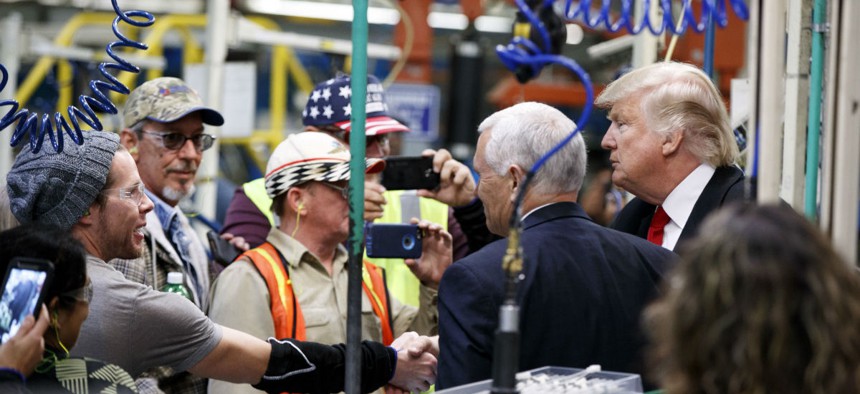Trump’s Risky, Off-the-Books Plan to Grow the Economy
The president-elect has a long history of achieving his goals with other people’s money. If it doesn’t work, we could be stuck with an even bigger government.
When Donald Trump said he was going to build a wall and make the Mexican government pay for it, almost no one took him seriously. But there’s an important clue there about how he’ll run his presidency.
Just look at the deal with Carrier to keep 1000 jobs in Indiana. Trump is pointing to that as one of the big pre-inauguration deals of his presidency—and a sign of what’s to come. How did he do it? It cost $7 million—in tax breaks from the state of Indiana. There’s no federal cash involved.
Think about the other big mega-deals on the table. There’s a $1 trillion infrastructure plan, which he proposes to finance through complex federal tax breaks for loans to be repaid over time by private borrowers. A trillion dollars worth of infrastructure that he says won’t add to the national debt.
Plans floated to repeal-and-replace Obamacare would provide federal tax breaks to citizens so they can buy private insurance. The Republican governors are lobbying to turn Medicaid into a block grant, which would give them more flexibility in the short run. But that flexibility would come with substantial long-term risk, as it would transfer hundreds of billions of dollars in costs for nursing home care for aging baby boomers from the federal budget to states.
Essentially, Trump would be putting his name on programs without putting the programs on the federal budget.
As a leader, Donald Trump is a deal-maker. As a corporate executive, he built his empire with OPM (other people’s money), convincing them to lend him vast amounts of cash to construct buildings with his name on the front. He’s now setting up policies in much the same way: big programs, funded with other people’s money and with tax plans that keep the costs off the budget.
It’s a very clever art of the federal deal. It’s allowing him to talk big without doing the one thing certain to rev up the Republican congressional buzz saw: explode the national debt.
These deals are allowing him to move out fast and put some points on the board. Perhaps most important, the deals are allowing him to shine a very bright Batsignal from his Manhattan highrise that he’s intent on dealing with the concerns of middle- and working-class voters.
But it’s full of risks as well. We’re now losing as much money in federal tax breaks as we’re putting into discretionary spending. Just think about that: tax breaks now cost as much as the entire federal budget, once we take away interest and entitlements. We rarely even take a look at, let alone review or budget, the tax breaks. We sweat bullets over outlays on the budget, to the point we’ve shut the government down over how much to spend. The art of the deal, for many of these initiatives, is to launch the projects without putting the cost on the budget.
Trump’s argument is that these deals will get the economy moving. Of course, we’re in the middle of an extraordinarily long expansion—but it sure doesn’t feel that way for many Americans. His implicit message is that he’s going to generate growth for the millions of Americans who feel they’ve been left behind. If he’s right, growth will more than pay for the tax breaks that will make it possible. And the strategy will fuel deals that would have been impossible in a gridlocked Congress obsessing over the deficit targets.
But there are also very big risks here. First, maybe the promise of economic growth won’t come true. We could get stuck with a much bigger federal establishment, woven far more into the economy and costing much more money. Financed with tax breaks, the real costs would be hidden from public view, congressional scorekeeping, and the national debt clock on 44th Street in New York, just a few blocks from Trump Tower.
Second, it could prove so tempting to spend other people’s money that it will be easy to make big (and expensive) deals without weighing the alternatives or knowing where we’re heading. The Indiana tax deal for Carrier raises huge questions—whether, where, and when we should do it again, for example. What’s to prevent companies from making threats to leave the country, just to shake down taxpayers? The art of the tax break deal has a much different rhythm and politics than the budget battles we’re used to watching.
Third, this off-budget game might be played—and won—by the well-heeled, who know the idiosyncrasies of the tax code and have the resources to play a game most of the rest of us don’t understand. Or benefit from.
And for a campaign that promised to drain the swamp, this could prove mighty swampy indeed.
Without even being sworn in, Trump has raised critical questions that only hint at fundamental changes down a very uncertain road.
Donald F. Kettl is a professor and former dean of the University of Maryland School of Public Policy.
NEXT STORY: The Foreign Policy Thorn in Trump’s Side




